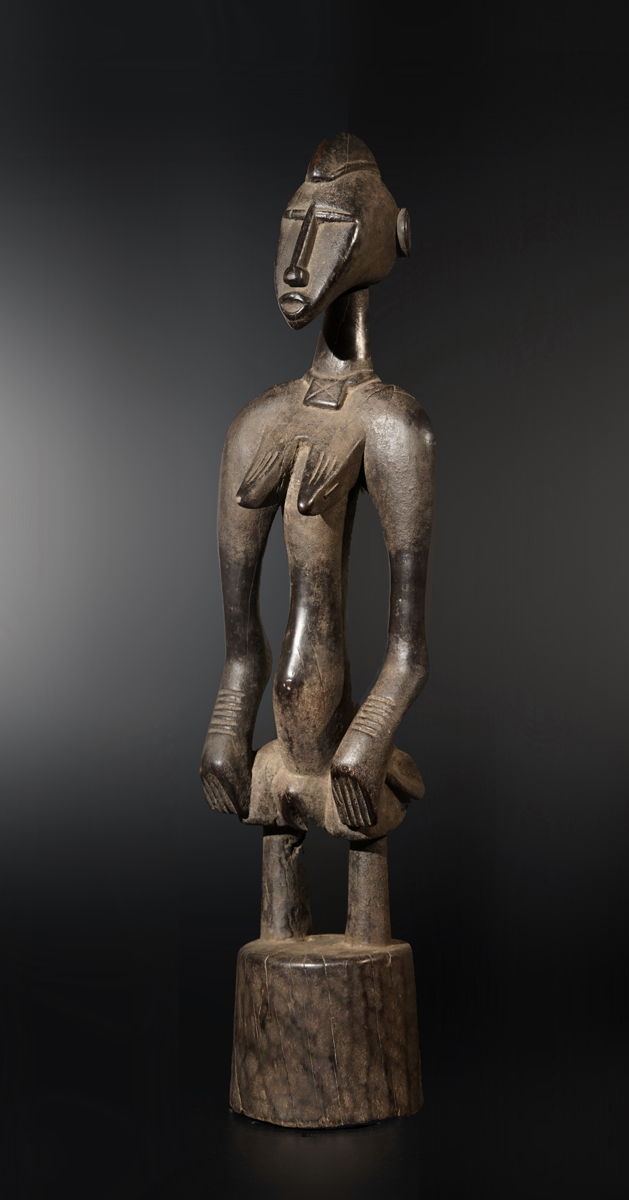 |

A female Senufo Rhythm Pounder or Guardian sculpture, Ivory Coast-Mali border region, standing on cylindrical base, short legs, broad hips and strong glutes, clearly defined labia, rounded shoulders, arms slightly bent, hands hanging down with fingers not closed, scarring on the wrists and pointed breasts, on the narrowing neck rests a head that is elongated downwards with a mohawk-like haircut, circular ears, the nose is long, straight and round at the tip, the lips are oval in shape, the eyes are closed, the statue wears a necklace with a square amulet; heavy dark wood, age patina, small age cracks, insect caused damage on the right buttocks, shiny parts on the face, neck, upper arms, belly, nipples and labia due to handling patina.
"This type of sculptures - kown under the name deble - is one of the most famous works of West African Art. After the early 1960th, when the Massa-movement destroyed most of the important Senufo objects, only a few old, authentic Rhythm Pounder were saved and came to Western world. There are no sculptures from the time before 1960 existing anymore in the Senufo region of Ivory Coast, Burkina and Mali. But in some rural regions the old animistic tradition is still existing and also the funeral ceremonies, in which the deble rhythm pounder has it's ritual function. There are differences in the ceremonies in comparison to the years before 1960. In particular the holy groves, doesn´t exist anymore or arn´t known by Western ethnologists. It were secret fields, where the Senufo placed their ritual sculptures in the forest.These precious objects would probably be stolen immediately, because in nearly every village the Islamic influence becomes stronger and there are more people, who are against the old animistic tradion than decades before. Now these objects are protected in huts close to the village.
Many of these Rythm Pounders were used like a hammer to open symbolically or more or less directly a hole in the thick adobe wall of a hut, to carry the dead body of a man - it´s a male sculpture - outside for funaral purpose. In the literature is only described the pounding on earth and the swinging over the ground, but not the described function, which is the reason for the desolat conditions of many déblé bases."
Lit.: Gottschalk Burkhard, "Senufo, Massa und die Statuen des poro", Glaze Anita J. , "Art and Death in a Senufo Village", Indiana University Press, Bloomington 1981, Goldwater Robert, "Senufo Sculpture from West Africa" - The Museum of Primitive Art New York, 1964.
Further Lit.: Kat. Ausst. Die Kunst der Senufo, Elfenbeinküste. Mit einem Beitrag von Till Förster, Museum für Völkerkunde Berlin 1990. Burkhard Gottschalk, Senufo. Massa und die Statuen des Poro, Düsseldorf 2002. Susan Elizabeth Gagliardi, Senufo unbound. Dynamics of art and identity in West Africa, 2015. Till Förster, Smoothing the Way of the Dead, A Senufo Rhythm Pounder, Yale University Art Gallery Bulletin (2005).
2.400 - 2.800,- Euro
Height: 90 cm
Weight: 6,7 Kg
|
 photo: wolfgang-jaenicke.com, for more information, please write us an e-mail with the identification number of the photo identification no. FXB06314.jpg
photo: wolfgang-jaenicke.com, for more information, please write us an e-mail with the identification number of the photo identification no. FXB06314.jpg |
|
